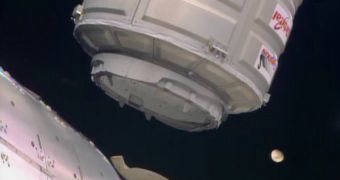Astronauts with the Expedition 38 crew aboard the International Space Station yesterday received the visit of Orbital Sciences Corporation's first private resupply spacecraft, the Cygnus unmanned capsule.
The vehicle launched aboard an OSC-built Antares rocket on Thursday, January 9, from Launch Pad 0A at the Mid-Atlantic Regional Spaceport (MARS), which is located at the NASA Wallops Flight Facility, on Wallops Island, Virginia. The mission is designated Cygnus CRS Orb-1.
The spacecraft arrived in the vicinity of the ISS on Sunday, January 12, and had to be grappled with the station's Canadarm-2 robotic arm. Cygnus cannot dock to the space lab on its own, so it has to be captured with the robotic arm as soon as it comes within range.
NASA astronaut Mike Hopkins was in charge of carrying out this complex maneuver, assisted by Koichi Wakata, an astronaut of the Japanese Aerospace Exploration Agency (JAXA). The process was successfully completed at 6:08 am EST (1108 GMT), when Cygnus was finally grappled.
By 8:05 am EST (1305 GMT) yesterday, the Cygnus spacecraft was safely attached to the Harmony utility hub on the ISS. This module was attached to the forward end of the Destiny laboratory on November 14, 2007, after arriving on the station during shuttle Discovery's STS-120 mission, on October 23, 2007.
Yesterday's berthing marks the successful completion of the first of eight resupply flights for OSC and its Antares/Cygnus combo. The company is under a $1.9 billion (€1.4 billion) Commercial Resupply Services (CRS) program contract with NASA to carry out these flights.
Cygnus delivers a total of 1,261 kilograms (2,780 pounds) of cargo to the International Space Station, including a large number of science experiments, spare parts, various hardware, and crew provisions such as air, water, fuel for the station's maneuvering thrusters and personal items for the six astronauts.
OSC is only the second private company to successfully reach the ISS under the NASA CRS/Commercial Orbital Transportation Services (COTS) program. The other company is Hawthorne, California-based Space Exploration Technologies Corporation (SpaceX), which operates the Falcon 9/Dragon rocket-spacecraft combo.
Once Cygnus finishes its stay on the ISS, it will be loaded up with around 1,000 kilograms (2,200 pounds) of trash and other unwanted items, and then deorbited and destroyed high in Earth's atmosphere.

 14 DAY TRIAL //
14 DAY TRIAL //